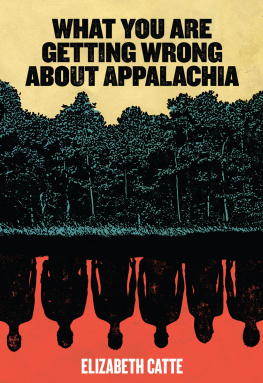Due to variations in the technical specifications of different electronic reading devices, some elements of this ebook may not appear as they do in the print edition. Readers are encouraged to experiment with user settings for optimum results.
Copyright 2016 by The University Press of Kentucky
Scholarly publisher for the Commonwealth, serving Bellarmine University, Berea College, Centre College of Kentucky, Eastern Kentucky University, The Filson Historical Society, Georgetown College, Kentucky Historical Society, Kentucky State University, Morehead State University, Murray State University, Northern Kentucky University, Transylvania University, University of Kentucky, University of Louisville, and Western Kentucky University.
All rights reserved.
Editorial and Sales Offices: The University Press of Kentucky
663 South Limestone Street, Lexington, Kentucky 40508-4008
www.kentuckypress.com
Cataloging-in-Publication data is available from the Library of Congress.
ISBN 978-0-8131-6697-1 (hardcover : alk. paper)
ISBN 978-0-8131-6698-8 (epub)
ISBN 978-0-8131-6699-5 (pdf)
This book is printed on acid-free paper meeting the requirements of the American National Standard for Permanence in Paper for Printed Library Materials.
Manufactured in the United States of America.
| Member of the Association of American University Presses |
Contents
William Schumann
Kathryn L. Duvall, Kelly A. Dorgan, and Sadie P. Hutson
Yunina Barbour-Payne
Amanda Zeddy
Anna Rachel Terman
Kathryn Trauth Taylor
Jessica Blackburn
Kirk Hazen, Jordan Lovejoy, Jaclyn Daugherty, and Madeline Vandevender
Jacqueline Yahn
Kristin Kant-Byers
Melissa Ooten and Jason Sawyer
Anita Puckett
Tim Ezzell
Diane N. Loeffler and Jim King
Mark Wilson
Gabriel A. Piser
Rebecca Adkins Fletcher
Introduction
Place and Place-Making in Appalachia
William Schumann
News from the Appalachian Mountains of the United States rarely garners national media attention, yet the region was in the national spotlight on several occasions during the first weeks of 2014. In the first case, journalists and a few politicians noted that 2014 was the fiftieth anniversary of the War on Poverty, a project that began during the presidential administration of Lyndon B. Johnson to assist areas of widespread socioeconomic deprivation that had been rediscovered in the postwar America of the 1960s. A previous presidential campaign visit by John F. Kennedy had marked Appalachia as an epicenter of the conflict. Reporters returned to the region in 2014 to assess the impact of the war and declare it unfinished. In the second instance, national coverage focusedvery brieflyon a coal-related chemical spill into West Virginias Elk River, which left hundreds of thousands of people without access to safe water. The polluting corporation (America First) announced bankruptcy as reporters raised questions about a link between the spill and underregulation of the coal industry. However, the medias attention soon shifted. In a final case, cable news and the popular media discussed the death of a Pentecostal preacher from eastern Kentucky who died from being bitten while handling venomous snakes. The preacher had been featured on a reality television series about snake handlers, but commentators focused on the dangers of traditional beliefs instead of recognizing the place of the deceased in the modern entertainment industry (the same place from which his critics spoke). If it was unusual for the region to be nationally recognized so often in a short span of time, it is also true that these cases drew attention for quite characteristic reasons.
Whether defined by the intensity of poverty, the dominance of energy interests, or the persistence of unorthodox lifestyles, each of these Appalachian stories operated on the principle of marking regional difference from a larger, more cosmopolitan United States. In fact, Appalachia has been defined by its distance from mainstream ideals and the practices of American modernity since the nineteenth century. It is not that reporters discovered new truths about the regions essential qualities; these representations were remarkably thin, dated, and based on simplistic reductions of politics, economics, and culture in Appalachia. The reality is, first, that Appalachia has never been fully reflected in the mirror of Americas popular imagination, and second, it has always been characterized by cultural diversities and global interconnections that challenge easy categorizations of regional identity. Exploring these dynamics, Appalachia Revisited examines Appalachia as a by-product of human-environmental relations in specific locales and as an outcome of creating knowledge about the region over time. Thus, this book is about Appalachian place and Appalachian place-making in the twenty-first century. We examine place as a human construct involving diverse human practices within changing environmental and historical circumstances. We analyze place-making as the production of popular and academic knowledge that establishes Appalachia as a distinctive cultural, economic, and ecological region.
The contributors to this volume offer a wide range of perspectives on the relationship between Appalachian places and place-making in Appalachia. Representing the humanities and social sciences, including academic and applied work, chapters address issues of regional health, environment, race, ethnicity, gender, economic development and tourism, linguistic and cyber identities, energy policies, prisons, activism and organizing, educational engagement, farming, and politics. These topics intersect at different points in case studies representing Appalachian Alabama, Kentucky, New York, North Carolina, Ohio, Pennsylvania, Tennessee, Virginia, and West Virginia. They trace an Appalachian map made up of dialectical speech networks, artistic performances, institutional relations, ecological communities, political and consumer practices, and virtual representations.
In order to examine the relationship between regional knowledge and how that knowledge is produced, the chapter authors were asked to actively discuss how they apply one of three tools of academic research to their Appalachian work: theory, method, or context. Chapters focused on theory outline key concepts of analysis that enable particular interpretations of Appalachia-specific data. Chapters focused on














